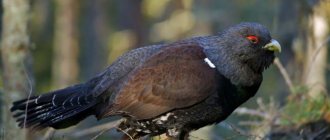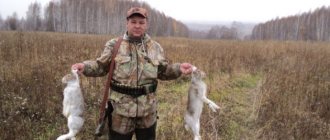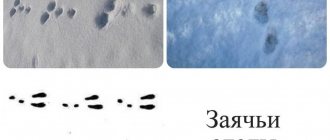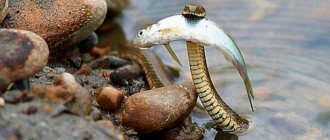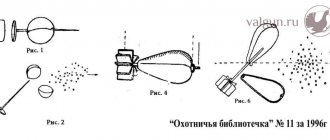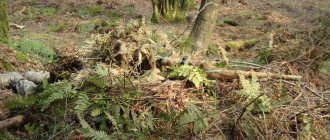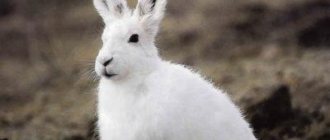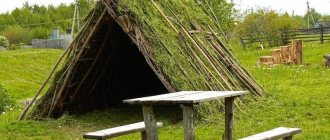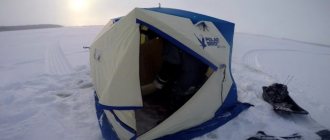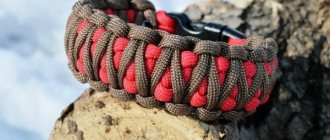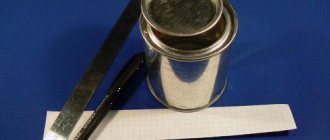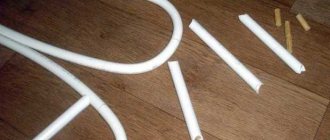White hare and hare: appearance, habits, habitat
There are two types of hares in Russia: the hare and the hare. The meat of these animals is a real delicacy. Whites live in the forest zone; their closest relatives, the hare, have chosen the steppe strip and meadows. White hare and hare in the wild interbreed, giving birth to a cuff - a hybrid capable of producing offspring.
Our whites live from the tundra to the forest-steppe zone, preferring spruce forests, burnt areas, river banks, and clearings. This hare weighs from 1.7 to 4.5 kilograms. Weight depends on the region of residence. Large individuals live in the Western Siberian tundra, but the Yakut hare grows small.
Any hare can run quickly even in bad snow thanks to its wide legs covered with thick fur. In spring and summer, the hare feeds on fresh grass and meadow clover at the edge of the forest; in autumn and winter, it has to eat aspen and willow bark. The hare is a nocturnal and twilight animal.
During the day he rests on a bed, and at sunset he begins to walk through the forest and look for food. By morning he stops being awake, greatly confuses his tracks and goes to bed for the day. Usually the white hare rests in a new place every day. On a frosty winter day, he buries himself in the snow, where the animal is warm and cozy.
But he is always on guard, as there are more than enough predatory enemies. In spring and autumn, hare molts. As the air temperature rises, the color of the coat becomes gray. And in the fall, the white hare gradually begins to turn white so that in winter it is not visible against the background of snowdrifts. Only the tips of the ears remain dark.
This animal hears well, but sees poorly (maybe that’s why it’s nicknamed oblique), so it can come close to a person standing motionless. The hare has a weak sense of smell, but he can run so fast! Fast legs are the main advantage of the white hare, otherwise the population would disappear. After all, he has many enemies.
White hare
In addition to hunters, these are foxes, wolves, birds of prey, lynxes, etc. But thanks to their fast legs and high fertility, the number of white hare does not decrease. Childbirth occurs two or three times a year, and from two to ten hares can be born. The hare is a steppe relative of the hare.
On the borders of the forest and steppe zones, these two types of hares are often found and can produce offspring. A hare can easily come to the forest and even the tundra and settle there. This hare is larger than a hare and weighs up to six kilograms. The northern hare is usually larger than its southern counterpart. In summer, the hare has a reddish-brown color, and in winter it becomes lighter.
But unlike the hare, the hare never takes on a snow-white coat color. After the April molt, which always begins from the head, the hare becomes dark again. In addition to the open steppe, this species of hares lives in clearings, clearings, meadows, and forest edges, preferring open areas.
Like the hare, the hare is also active at night, and during the day in winter it sleeps in the snow, in the warm season - in a hole under a windbreak or in the thick of the grass. The hare is often seen on farmland, where he likes to steal root crops and melons, turning into a pest.
This animal has developed hind legs, which allow it to run at a speed of eighty kilometers per hour. He's rolling head over heels down the mountain. On the plain, he jumps in different directions, covering his tracks. His sense organs are developed in the same way as those of the hare. The winter hare often approaches people's houses.
His food becomes scarce in winter. The fertile hare gives birth one to three times a year. If it has been warm all year, there may be up to five births. Both types of hares are popular subjects of hunting under license. The timing of the hunt should be clarified with the regional executive authority responsible for hunting.
In some regions of the Russian Federation, hunting begins in mid-September, while in others the ban may last until November. The easiest time to catch a hare is closer to winter, in the first snow. In spring and summer, hunting is prohibited, as these animals reproduce and poaching antics can cause enormous damage to the hare family.
Brown hare
Hunting without weapons: the simplest traps - snares
Our distant ancestors always knew how to hunt: they understood the types of weapons and knew how to independently make the simplest traps for animals, since this was one of the main ways of obtaining meat, fur and bones in those days.
After many centuries, hunting faded into the background and became more of an entertainment, and the production of meat and poultry was reduced to their purchase in the meat departments of city supermarkets. But knowing how to build simple traps and where to place them will help you get food in a variety of life situations, especially when you find yourself in the wild and are not the proud owner of a firearm.
Traps are most often used to catch birds or small animals. In the manufacture of traps, the simplest materials are used that can be found in any person’s household.
The simplest and most uncomplicated trap is a snare. A snare is a loop tightened on the body of an animal, made of nylon thread, horsehair, fishing line, metal wire, etc. Brass wire with a thickness of 0.5-2.2 mm will be practical to use. Snares can be tightened automatically - using a weight attached to a loop: a lever or a spring tree. The noose can be tightened by the hunter or the animal itself when caught in it.
Snares can be installed near an animal's burrow - these are burrow loops. And on an animal trail there are trail loops. During the fixation process, the loop must be masked with grass juice so that it becomes inconspicuous to the animal. To prevent a predator from chewing through the wire, you need to cover the thread loop by loop with a tubular bird bone or a piece of wood with the core removed.
Burrow loops are used for catching foxes, gophers, badgers, and are suitable for hunting in both forests and deserts. The trap is suspended along the diameter of the hole to a height of 3-4 fingers. That is, when an animal gets into a noose, when it tries to free itself, it will tighten it on itself. In another case, the loop is installed closest to the mink. When a predator gets inside the trap, the hunter will quickly pull the noose around the body or legs of the prey.
The figure below shows how to install a trap right at the entrance and exit of a burrow. The far end of the loop is secured with a peg driven into the ground. The loop itself is identical to the size of the entrance hole of the mink and is located at a distance of several centimeters from it. Above - protected by tubular bone.
Trail loops are installed on animal trails where there are fresh tracks, droppings or fur of animals. If you expect to catch an elk, roe deer or other large animal on a trail loop, then to make it you need to use strong steel wire to make a triple ring out of it. But it’s better not to rely on this method of catching big game. The loop will not withstand the power of the animal and will break. And you will simply lose a lot of time, since such large animals are very careful and have an excellent sense of smell. A foreign smell or visible changes in their familiar environment will serve as a signal for them to be in danger. Therefore, trail loops are best used for catching hares. The wire for the loop should be no thinner than 0.8 mm so that the hare cannot tear it. The loop is installed in clearings and clearings where hare trails pass. They will be most visible in the snow. The loop should be wide, 20cm in diameter. It is suspended at a height of 13-16 cm from the ground and secured to a tree branch.
To hunt birds, the simplest traps are placed at points where they accumulate: in nesting areas, in shallow waters, and in feeding areas. The trap is constructed from stakes in the form of geometric shapes and bait is placed in the middle. Several passes are made between the stakes, where 2-3 loops are hung side by side. The far end of the loop is secured in a slot made at the end of the guard branch. These traps are called “towns” (see picture).
Hunting with a hound
Hares are hunted with hounds along both the black trail and the white trail. In the first case, they go hunting after the leaves have fallen, when there is no snow yet, and it is already light in the forest due to the bare trees. The barking of a dog can be heard by a hunter from afar. White trail hunting has another advantage.
A fisherman can see the tracks of a hare in the first snow. But there are also disadvantages: movement in the snow is slower, the creaking noise from movement frightens the animal, and the hound’s audibility deteriorates. The hunter usually goes into the forest in wet late autumn, since it is easy for the dog to work on moist ground.
But in dry weather, the hound has a hard time smelling the trail of a hare, since fallen leaves scatter other odors everywhere. You should not go hunting in windy or rainy autumn weather. In the first case, it is impossible to hear the hound's bark; in the second, the dog does not find the tracks because they are washed away by the rain.
You cannot hunt with a dog in cold weather, otherwise the hound’s paws will get severely frostbitten. During the period of shedding leaves, the hare begins to be afraid of the noise of falling leaves and goes into spruce, pine and forest edges. After leaf fall, the hare begins to hide under fir trees or fallen bushes. It can be found in swamps or young spruce forests.
After the first snow falls, the hare looks wary for the first 24 hours and only takes a short walk. But after a day he begins to wander everywhere, and the dog easily finds the trail through the undetected powder. You should go hunting in the morning, when the trail has not yet cooled down. A hunter and a hound slowly walk around the hunting grounds.
The dog is encouraged by voice to look for the trail and pick up the hare. The hunter points the dog to the trail, and the hound follows the trail and as soon as it sees the animal, it begins to bark. If a dog barks loudly and continuously, this is a sign to the owner that the animal has been found and raised from its bed.
The hunter gives the hound a signal to chase the hare, which begins to walk in circles and confuse the tracks. Even a wounded white hare fights for life, cunningly moving away from the hunter and the dog in a wide circle. The wide and small circles form a double circle, which can be untangled by an experienced hunter and an experienced hound.
Rusak behaves differently. He does not run away from the chase in circles, but immediately takes off and runs into distant fields. But after running three kilometers, the hare calms down and returns to lying down again. This stupid character of the hare is familiar to all hunters. Therefore, they just have to wait for the hunted object to approach the ambush again.
Running brown hare
It often happens that the hare ends up in a good shooting zone due to the fact that he himself got confused with the circles that he made unsuccessfully for himself. The hare's rut rarely takes place in open areas. Usually the hare is chased through dense undergrowth and the edges of lowlands. It often happens that a dog barks in the distance, and a hare is close to the hunter.
In this case, the hunter, frozen in place, takes aim and shoots. But if the animal and the dog are close to each other, then you should not shoot, otherwise there is a possibility of injuring the hound. Hare hunters often make this mistake. They see a wood grouse or a duck and hit the bird.
They believe that tasty game is also a good trophy. The dog hears the shot, stops chasing the white hare and runs up to its owner. The dog sees the bird and from that moment becomes spoiled, since from now on he will begin to chase not only hares, but also run after birds barking.
Preliminary results
Here we are, taking our time, and examining in great detail how to put loops on a hare (or hares). But an experienced hunter will only laugh at our naivety. He will tell you that loops should be placed only on “fresh” trails. That is, before installing traps, you should make sure that the scythe has not left the trail and is still using it when going to feed and back. If it is frosty all week and there is no snow, then you are unlikely to distinguish the old track from the new one, which means you will not be able to install your loops correctly. Blizzards, blizzards and other similar “delights” of winter also do not contribute to normal hunting. By the way, when inspecting the loops, it is advisable to walk, as they say, “footprint after trail.” In this case, there is hope that the snowstorm will not cover your tracks, and you will not step on a hare’s path anywhere. You can read a lot of hunting literature, but still not try hare meat caught with your own hands. It was not for nothing that the classic said that experience is the son of difficult mistakes... As Marxists argued, only practice confirms or refutes theory. Armed with knowledge, it is necessary to test it in practice, that is, to hunt. Now you know how to catch a hare with a noose. But it is still advisable to go hunting for the first time not alone, but in the company of a more experienced friend, since there is always something to learn from him.
Hunting for a hare on the Uzerka
Hunting for a hare comes from the old Russian word uzret, meaning to see. They don’t take a dog on such a hunt. They hunt during the moulting period of the animal, when the hare is not so anxious and cautious. It is best to go to the forest in the fall after rain or during the first snow.
In dense undergrowth, the molting hare feeds on bark and leaves, and so it rests in a bed. It begins to fatten before a long and harsh winter near clearings and fields with winter crops, gradually changing its fur cover. In autumn it gets dark quickly, so they go hunting early in the morning.
After a night of rain, a timid hare usually hides in the grass. Traces of the animal can be found in droppings and trampled grass. They go on such a hunt in a small group. The hunters are located at a distance of fifty meters from each other, slowly and carefully move in a chain, combing the forest area.
In late autumn there is no snow yet, but the hare has already turned white. Therefore, he is noticed in dry leaves without the help of a hound. Sometimes white hare is seen in the field. The hunter often stops and goes straight to the animal. Usually, hunters have to wander for a long time through windbreaks, undergrowth and arable land. The more you travel, the higher the chance of a successful shot.
Hare hunting in winter
Hunting for a hare by following the scent
As soon as the first powder falls, the hunter begins tracking the hare through the shallow snow. This activity also takes place without the help of a dog. They usually go hunting after a short overnight snowfall. It’s not difficult to move through such snow, and you can look for traces of a hare that has gone out to feed at night without any problems.
You should not go hunting if there is dead powder, that is, there has been no snowfall for a long time and the tracks are confused because of this. If the powder is short, then the hare trail will be bad due to the cessation of snowfall only in the morning. It is best to go hare tracking in mild weather with little wind. The hunt takes place in the morning, when the hare is calm.
In bad weather, the scythe often gets up from its prone position before the shot is fired. A night hare walks through the forest, looking for food. It leaves footprints in the snow, clearly indicating the jumping and running of the hunted object. Daytime sleep on a hare's bed begins in the morning. Before this, he makes many loops and circles to confuse predators and hunters.
A hunter follows a hare's tracks. He looks for the scythe along haystacks, farmland, along the edges of forests, along trails. Twos and threes made by a forest dweller will not confuse an experienced hunter. He knows how to distinguish between the tracks of a hare and a hare, and always walks away from the tracks so as not to trample the animal’s path.
The hare always walks in deep snow, while the hare prefers to move along paths and open places. The hare's droppings are smaller than those of the hare and have an oval, but not flattened shape. Hunters know how to untangle fat marks and distinguish a rutting trail from a loop or discount.
The hare's movements in small jumps make the tracks recognizable. Often the tracks of different hares intersect with each other. The running trail leads directly to the animal's resting place, so the hare is most cunning on such a trail. He can suddenly change his course and come back.
Hare hunting in summer
It is not for nothing that the hare is considered one of the most cunning forest animals. But the process of hunting for it is exciting and interesting, for hunters who know how to think. An inexperienced hunter makes the mistake of not going around the loop completely and getting lost on the trail of another hare. The hunter must be constantly in slow motion, otherwise the hare lying down will get up and run away.
They look for the white hare's bedding in spruce forests, windbreaks and undergrowth. A hare on a day's rest is trailed near the roots of trees, at the top of snowdrifts, near huts, fences, and old huts. The hunter notices the hare and shoots at it before it gets up and runs away. Next, you need to make sure whether the animal is wounded or killed.
If the animal runs away, you need to let it calm down and only then start hunting for it again. Usually, even an experienced hunter who hunts three birds with one stone, more often than not catches only one, or at best two, since this is not an easy task.
It takes practice, and many factors always work in favor of the hare. To increase success in tracking, the hunter can take a partner to follow the trail himself, and give his friend the opportunity to look around.
Selecting a location
The main place for installing trapping loops is hare trails. In winter, they are easy to spot near the hare’s likely feeding areas:
- hare - along rural lands, fields, vegetable gardens, meadows and meadows, under stacks and stacks of straw, closer to mid-winter in gardens;
- hare - in ravines and floodplains overgrown with young willow trees, in young aspen and birch forests, in gardens and summer cottages.
A hare trail can be called a place in the snow on which there are at least three hare tracks, or clearly visible tracks of at least two hares. But you need to make sure that it doesn’t turn out to be a hare two or three.
hare trail
The easiest way to catch a hare is where the snare is hard to see and the path is limited on the sides. The installation location is chosen in a bush or near trees, preferably between them, so it is easier to tie the trap and it will be less noticeable.
The loop is placed above the path, at a height of 10–15 cm from the snow level, so that the hare runs head first into it.
Familiarize yourself with the intricacies of tracking and reading hare tracks in the first snow.
Hunting for a hare from ambush
Along the autumn black trail and in winter they hunt a hare from ambush . Shelter is made near harvested fields, in willow and aspen groves, near gardens and behind the vegetable gardens of the last village houses. The abundance of hare tracks usually indicates the need to build a hiding place from branches in this particular place. The hunter sits in a shelter, unnoticed by the hare.
And at this time the scythe goes to feed near the shelter and comes into the hunter’s field of view. The shot hits the hare to the hunter's delight. The hunt will take several hours. Therefore, you need to dress warmly, take a seat and a thermos with hot tea. If it is winter, you need to dress in warm clothes the color of snow to have good camouflage.
You can’t make noise, buy or drink alcohol in the shelter, otherwise the hare will smell it all and won’t come close. Usually, in the silence of the shelter, the movements of the approaching hare are first heard, and after some time the slanting hare itself becomes visible. But if the weather is bad, then you should not hunt from ambush.
Wind and bad weather will prevent you from both hearing the hare and seeing it. The shot will most likely be unsuccessful. Night hunting has the disadvantage that bushes and trees cast shadows, and therefore it is difficult to make an accurate shot. It is necessary to shoot at the object of hunting only when the hare has begun to feed.
Hunting equipment, safety measures
The hare hunter moves through the forest for a long time. He walks many kilometers and therefore must dress correctly. Clothing should be at the same time warm, light, waterproof and not interfere with movement. You can always buy such a suit in hunting and fishing stores.
It is best to choose an autumn suit to match the color of fallen grass and autumn leaves. Khaki clothes are great. During the first snow, it is better to hunt in white clothes with dark spots, since there is still little snow in nature and there are many open areas of land. And for winter hare hunting it is better to buy a snow-white suit.
Hunting clothing should always be clean, smell like the forest, without foreign odors, and not rustle. The creaking and noise of clothes can always alert a hare. Shoes should also be light, not rustling. You should purchase shoes that fit so that you can easily walk for many kilometers.
For autumn hunting, rubber boots are suitable, and winter hunting for deer is best done in felt boots or EVA shoes. Long walks through the forest may require the purchase of skis. It is best to buy wide wooden skis that match the hunter’s body weight and height. An excellent option is lamps; they do not creak or rustle while hiking in the snow.
And if they are also upholstered on the bottom with animal skin, then such lamps will never sink even in the deepest snow. A hunter shoots at a hare, but by chance the bullet may hit another hunter or a dog. Therefore, when hunting you need to be collected and careful.
